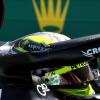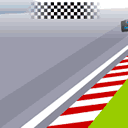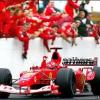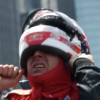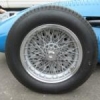
Safety car v Virtual Safety car
#1

Posted 31 July 2019 - 18:03
When the Safety car goes onto the track, Bert Marylander drives it around as quickly as he can, so that the cars can keep some heat in their tyres, or at least, that's what I'm given to understand. I also understand that this slower speed is to make it safer for marshals to remove damaged or broken down cars. Fair enough.
However, if the VIRTUAL Safety car is instigated, I believe drivers must adhere to a speed limit that I thought I heard described as 100 kph.
Now my problem is, behind Maylander, all gaps between cars more or less disappear, which annoys me intensely and ruins my enjoyment of the racing. If Maylander is driving at 100 kph or even more, what is the point of the Safety car? Surely, every incident could be dealt with by the virtual system and thus, drivers who have worked very hard to build a gap would not see it all disappear in a lap or so.
I'm sure this is a very naïve question, but it bugs me beyond belief and is the reason why, personally, I didn't enjoy Germany anything like as much as the rest of the population of planet Earth.
Advertisement
#2

Posted 31 July 2019 - 18:30
#3

Posted 31 July 2019 - 18:32
I believe the VSC "delta" is somewhere in the range of 40% slower than the actual racing lap, and it's calculated for every "mini-sector" on the track. 100 kph is excessively slow, i'm pretty sure they're doing more than that.
While the VSC slows the cars down and in theory maintains the gaps (in practice - it doesn't, because a lot depends on where on the lap you are when VSC is deployed or withdrawn, since it is not the same if you're in the middle of a slow corner or on the fastest straight and one can gain or lose quite a lot of track position based on that, and nevermind the exploit with pitting under VSC and jumping all the cars that pitted just a lap or two before), sometimes that is not enough, if the corner workers need more time to deal with the hazard on track. In those cases, the real SC has the advantage to condense all the cars into one part of the track leaving the rest free for the marshals to safely do their stuff, at least until the SC makes it around the whole track again, instead of having cars passing through every 4-5-6 seconds or so. Because even under VSC speeds they're still pretty fast and one wouldn't want to accidentally get in their way. But the downside is that all the gaps between the cars are neutralized.
#4

Posted 31 July 2019 - 18:54
Health and Safety rules. Unfortunately.
#5

Posted 31 July 2019 - 19:03
The VSC is not a 'speed limit' its a time limit, you can't go faster than a certain time through each of the mini sectors basically.
So you can accelerate hard then brake had, as long as you don't go below the delta that has been set, but it's not a speed limit.
You could accelerate up to 200KPH then brake had back down to 60KPH and still stay below the delta for example.
#6

Posted 31 July 2019 - 19:08
I guessed this was the sort of reply that would be forthcoming.
Health and Safety rules. Unfortunately.
Not unfortunately if you’re a marshal!
#7

Posted 31 July 2019 - 19:11
As the start is by far the most exciting part of most races I'm leaning towards standing starts following all SC/VSC periods.
Unless Lewis is in the lead at the time...
Edited by robefc, 31 July 2019 - 19:11.
#8

Posted 31 July 2019 - 19:11
Nowadays, it appears, that risks are no longer allowed.
#9

Posted 31 July 2019 - 19:12
I have been a marshal and I signed a waiver to the effect that I accepted the risks involved in doing the job.
Nowadays, it appears, that risks are no longer allowed.
Hasn't the SC been part of the sport forever?
#10

Posted 31 July 2019 - 19:14
I have been a marshal and I signed a waiver to the effect that I accepted the risks involved in doing the job.
Nowadays, it appears, that risks are no longer allowed.
That's great for you. But I'm sure there are plenty of marshals who would rather go home to their families at the end of the day than be mowed down by an errant car. Dangerous things are dangerous. There's no need to just accept that, especially from volunteers.
#11

Posted 31 July 2019 - 19:19
Hasn't the SC been part of the sport forever?
No, in modern Formula One the Safety Car was introduced in 1993.
#12

Posted 31 July 2019 - 19:26
No, in modern Formula One the Safety Car was introduced in 1993.
Ok, thanks.
For the OP - I'm not sure the last 26 years counts as 'nowadays'
#13

Posted 31 July 2019 - 19:43
VSC was introduced much more recently though.
VSC is much preferred in my opinion, by being over quicker and not ruining the flow of the race (as much) or influencing strategy (as much).
However, Lewis Hamilton managed to lose control of his car even under (V)SC conditions in last race, and had marshalls started attending to Leclerc's car, it could have been dangerous for either.
In my opinion, losing control of the car in any yellow flag situation is an absolute offence, warranting even DQ, as you show you don't take safety of others seriously.
#14

Posted 31 July 2019 - 20:22
Personally I much prefer the Safety car because everybody is bunched up and that almost always improves the show.
#15

Posted 31 July 2019 - 20:35
I've got some good news for you: the safety car and slow zones can be dangerous!!!I have been a marshal and I signed a waiver to the effect that I accepted the risks involved in doing the job.
Nowadays, it appears, that risks are no longer allowed.
#16

Posted 31 July 2019 - 20:54
Even the safety car can be dangerous!
#17

Posted 31 July 2019 - 21:34
No, in modern Formula One the Safety Car was introduced in 1993.
Apart from a brief try out in Canada in 1973 https://www.youtube....h?v=rnDAXHy4UD4
#18

Posted 01 August 2019 - 07:49
One thing I'm not sure about is if the VSC delta speed is faster than the SC. That might explain why they kept using the SC for the accidents at turn 16, fearing that another car could go off even at VSC speeds. I can't say I blame them if that is the case - you only had to put one wheel off the track to end up in the barrier, after all.
Edited by Spillage, 01 August 2019 - 07:50.
#19

Posted 01 August 2019 - 07:54
I'm be honest, I felt the same as you that the VSC just made more sense until someonw pointed out that the full SC intentionally bunched up the cars so that the marshalls had a couple of minutes to get onto the track to clear issue safely. However, in terms of racing I'd prefer a different solution that maintains the safety of the marshalls. Perhaps the cars need to go into the pits and wait until the track is clear before being released with the same tinme gaps as they had when the SC was called? People say that the cars aren't designed to stop and start like that, so change them?
I actually love safety car periods because they tend to improve the race, but that really just highlights a fundamental flaw in F1 at the moment! If we need to rely on a SC to make a race interesting then suddenly Bernies idea of having randomly activated sprinkers doesn't sound so daft.
Advertisement
#20

Posted 01 August 2019 - 07:55
The GP at the weekend was an explicit example of the flaws in the VSC 'delta' system.
You encourage a 'free pitstop', people gambled on slicks. LeClerc went off under VSC trying desperately to stop losing heat from his new slicks, and then Hamilton went off and nearly hit LeClercs car in the wall (As Charles was walking away trackside). I think wer'll see VSC phased out of wet races in the future.
#21

Posted 01 August 2019 - 08:00
The GP at the weekend was an explicit example of the flaws in the VSC 'delta' system.
You encourage a 'free pitstop', people gambled on slicks. LeClerc went off under VSC trying desperately to stop losing heat from his new slicks, and then Hamilton went off and nearly hit LeClercs car in the wall (As Charles was walking away trackside). I think wer'll see VSC phased out of wet races in the future.
Delta exists under SC too before they catch up.
Cheap pit stop could be eliminated by lowering pit lane speed limit during VSC.
#22

Posted 01 August 2019 - 08:08
You get free pitstops under the normal safety car too. In terms of messing up the race and the competitive element, the normal safety car is far worse than the virtual one.The GP at the weekend was an explicit example of the flaws in the VSC 'delta' system.
You encourage a 'free pitstop', people gambled on slicks. LeClerc went off under VSC trying desperately to stop losing heat from his new slicks, and then Hamilton went off and nearly hit LeClercs car in the wall (As Charles was walking away trackside). I think wer'll see VSC phased out of wet races in the future.
#23

Posted 01 August 2019 - 08:33
#24

Posted 01 August 2019 - 08:47
SC & VSC only really became necessary because the overpaid top echelons of the sport could not keep their egos under control and conform to the rules of the sport regarding yellow flags.
Edited by ExFlagMan, 01 August 2019 - 08:54.
#25

Posted 01 August 2019 - 09:00
There was a closed pitlane during SC's end noughties, but that was in the refueling era. Since it costs 2-3 laps to bunch up the field, you could run out of fuel. Without refueling, you could close pitlane again so the free stops are out.
That would be equally unfair to those that have built up a gap to pit right when a SC comes out. It would pay lucky dividends to those who happend to have just pitted before.
Perhaps close the pit land during VSC as that keeps the gaps more or less the same. Then I do think VSC should last always a period of (a) full lap(s) which would eliminate advantages based on which part of the track you have to go through VSC.
Or we should just accept there's a bit of luck of the draw every now and then and enjoy the mixup it sometimes creates.
#26

Posted 01 August 2019 - 09:27
SC & VSC only really became necessary because the overpaid top echelons of the sport could not keep their egos under control and conform to the rules of the sport regarding yellow flags.
It's not (only) about egos. Points means prize-money.
#27

Posted 01 August 2019 - 09:27
Then I do think VSC should last always a period of (a) full lap(s) which would eliminate advantages based on which part of the track you have to go through VSC.
No, it wouldn't. It's not where you go through, but where you are when it comes and goes. Being on a fast bit is a disadvantage both ways.
#28

Posted 01 August 2019 - 09:30
The GP at the weekend was an explicit example of the flaws in the VSC 'delta' system.
You encourage a 'free pitstop', people gambled on slicks. LeClerc went off under VSC trying desperately to stop losing heat from his new slicks, and then Hamilton went off and nearly hit LeClercs car in the wall (As Charles was walking away trackside). I think wer'll see VSC phased out of wet races in the future.
Hamilton went off under Full SC no?
#29

Posted 01 August 2019 - 09:31
Or we should just accept there's a bit of luck of the draw every now and then and enjoy the mixup it sometimes creates.
Yep, either way you do it, someone get's screwed.
They close the pits in IndyCar and occasionally someone get's burned by staying out and trying the stretch the fuel mileage.
VSC has it's uses. A bit of debris on the track? Yeah, quickly neutralise the race so someone can run on and fetch it. Car in the wall requiring bodies and machinery trackside, throw an SC and retrieve it once the field is stacked up.
#30

Posted 01 August 2019 - 09:34
Hamilton went off under Full SC no?
Yeah, think so. It was all a bit of a blur.
Either way, there is still an incentive to go as fast as possible (within delta) to catch the SC. I accept there was a level of force majure on Sunday as it started raining again just as everyone went to slicks. Hamilton wasn't driving recklessly.
#31

Posted 01 August 2019 - 09:45
I still think it should be automatic penalty when you go off on your own under yellow. The downside of a maybe unfair penalty sometimes is not too much for more insurance that yellows are respected.
#32

Posted 01 August 2019 - 09:50
With the VSC there are cars all around the track, even if going slowly, so there’s no gap in traffic for marshals to work on actual track. When a SC is deployed the cars end up in a crocodile behind it so marshals have some clear track.
Yes that's the theory but the reality is quite different. With cars initially catching the crocodile, they could have been 99% of a lap behind the SC if they were the last car to pass the pit exit when the SC comes out, and this can take well over a lap to catch the SC crocodile at some circuits, meaning they probably pass the "incident zone" at least once, sometimes twice at close to racing speeds during the first crucial minutes after a serious incident. Then with cars pitting during the SC period there could be a random car or more running at close to racing speeds at any point during the incident recovery in order to catch the crocodile again. All we generally see on TV is an orderly crocodile following the SC, but live at a race, in view of an incident causing a SC.. you will see MANY cars passing the zone very quickly at various times during the phase. There is rarely more than a couple of minutes goes by without a quick car passing for some reason. The VSC is clearly MUCH safer than the SC as it can instantly limit speeds around an incident, or even the whole circuit. In my mind the SC is quite obviously obsolete in "safety" terms, its benefit is its impact on the "race"...
#33

Posted 01 August 2019 - 09:56
I still think it should be automatic penalty when you go off on your own under yellow. The downside of a maybe unfair penalty sometimes is not too much for more insurance that yellows are respected.
What if an accident causing the yellows dropped a load of oil, or what if it started raining heavily with cars on slicks or what if a car suffers a mechanical failure?
I don't understand why they can't use the pit limiter enforcement around accident zones, it seems a ready made solution for forcing reduced speeds. Maybe have 3 levels with 3 buttons red, orange yellow and depending on the incident, FIA simply says VSC starting, "Red" or "Orange" or "Yellow".
#34

Posted 01 August 2019 - 09:56
That would be equally unfair to those that have built up a gap to pit right when a SC comes out. It would pay lucky dividends to those who happend to have just pitted before.
Perhaps close the pit land during VSC as that keeps the gaps more or less the same. Then I do think VSC should last always a period of (a) full lap(s) which would eliminate advantages based on which part of the track you have to go through VSC.
Or we should just accept there's a bit of luck of the draw every now and then and enjoy the mixup it sometimes creates.
This is what allowed Renault to cheat in Singapore 2008.
For safety, they could consider banning pitting under VSC or introduce an absolute speed limit (both rules in F2, in terms of the mandatory pit stop).
#35

Posted 01 August 2019 - 10:04
Yes that's the theory but the reality is quite different. With cars initially catching the crocodile, they could have been 99% of a lap behind the SC if they were the last car to pass the pit exit when the SC comes out, and this can take well over a lap to catch the SC crocodile at some circuits, meaning they probably pass the "incident zone" at least once, sometimes twice at close to racing speeds during the first crucial minutes after a serious incident. Then with cars pitting during the SC period there could be a random car or more running at close to racing speeds at any point during the incident recovery in order to catch the crocodile again. All we generally see on TV is an orderly crocodile following the SC, but live at a race, in view of an incident causing a SC.. you will see MANY cars passing the zone very quickly at various times during the phase. There is rarely more than a couple of minutes goes by without a quick car passing for some reason. The VSC is clearly MUCH safer than the SC as it can instantly limit speeds around an incident, or even the whole circuit. In my mind the SC is quite obviously obsolete in "safety" terms, its benefit is its impact on the "race"...
I thought that drivers were supposed to slow down (and be prepared to stop) in the sectors where a yellow flag was displayed.
Maybe the FIA should look at the timing for each car as it passes through the yellow flag zone and impose a stop/go penalty for anyone who fails to properly comply - pretty sure the drivers would soon catch on...
#36

Posted 01 August 2019 - 10:12
What if an accident causing the yellows dropped a load of oil, or what if it started raining heavily with cars on slicks or what if a car suffers a mechanical failure?
I don't understand why they can't use the pit limiter enforcement around accident zones, it seems a ready made solution for forcing reduced speeds. Maybe have 3 levels with 3 buttons red, orange yellow and depending on the incident, FIA simply says VSC starting, "Red" or "Orange" or "Yellow".
I agree. It baffles me how Leclerc could walk around while no hard speed limit was imposed. Meanwhile everyone had to adhere to a delta miles away from the incident. In this specific case he shouldn't have been allowed to leave his car imho, not until the pack was under control.
When Ricciardo's car failed it looked like his engine blew up, Verstappen was warned by his engineer about possible oil on the track, is there anything apart from a red flag to slow people down sufficiently in a situation like that?
#37

Posted 01 August 2019 - 10:16
Slippery Surface flag & common sense from the drivers - unfortunately the latter seems to missing from the top echelons of the sport - maybe because they do not have to pay for damage to their cars, unlike club drivers.
#38

Posted 01 August 2019 - 10:31
Even the safety car can be dangerous!
Franz Engstler can be dangerous.
#39

Posted 01 August 2019 - 10:38
Franz Engstler can be dangerous.
Franz Engstler IS dangerous.
Advertisement
#40

Posted 01 August 2019 - 10:39
I was very puzzled by a couple of the SC interventions on Sunday.
I can see why a full SC is needed if there is debris or dirt or gravel on the track, requiring marshals to go onto the track to clear it up. I cannot see why a full SC is needed for recovery of a car from beside the track.
I know they like to throw the SC when the medical car enters the track, to "protect" the medical car from race traffic by holding the field behind the SC, although to be honest I can't really see the need for that either. If the drivers aren't trusted to be able to see, avoid and safely overtake the medical car when circulating under VSC deltas, then that's frankly worrying.
On Sunday, though, we had full SC interventions without any obvious reason. Maybe muck had been dragged onto the track and the opportunity was taken to allow marshals onto the track to clean up? I'm not sure.
#41

Posted 01 August 2019 - 10:44
Under these conditions I would only use Safety Cars. Under VSC drivers are too eager to push the limits, and since there is a bigger chance of this going wrong under these conditions plus a bigger likehood of also being on the wrong tyres it's asking for an incident to happen. Of course the same can also happen under the SC, but it's way less likely.
#42

Posted 01 August 2019 - 10:52
It seems if a recovery vehicle is on the circuit in the line of fire of cars they will pull a SC out, ever since Jules Bianchi they will want to minimize the risk as much as possible. I don't think there is that much diff between SC and VSC but SC is probably slightly safer.
#43

Posted 01 August 2019 - 10:58
SC & VSC only really became necessary because the overpaid top echelons of the sport could not keep their egos under control and conform to the rules of the sport regarding yellow flags.
I thought that drivers were supposed to slow down (and be prepared to stop) in the sectors where a yellow flag was displayed.
Maybe the FIA should look at the timing for each car as it passes through the yellow flag zone and impose a stop/go penalty for anyone who fails to properly comply - pretty sure the drivers would soon catch on...
When I read in my 1956 Oulton Park programme that a waved yellow meant "slow down and be prepared to stop" I couldn't see how that was practical, and the general lack of attention to yellows was the same amongst the mainly amateur drivers then as it is with F1 drivers now. Nothing has changed; waving a bit of rag is a good warning but it's hardly a precision instrument.
These days we do have the technology and (as covered in another thread) I think we should use the VSC, and control both gaps and pace with telemetry, speed limiters and so on. If there are occasions when it helps to bunch up the cars let's do it, then "unbunch" them afterwards before resuming. Not difficult. (Famous last words).
#44

Posted 01 August 2019 - 12:10
#45

Posted 01 August 2019 - 12:32
When I read in my 1956 Oulton Park programme that a waved yellow meant "slow down and be prepared to stop" I couldn't see how that was practical, and the general lack of attention to yellows was the same amongst the mainly amateur drivers then as it is with F1 drivers now. Nothing has changed; waving a bit of rag is a good warning but it's hardly a precision instrument.
These days we do have the technology and (as covered in another thread) I think we should use the VSC, and control both gaps and pace with telemetry, speed limiters and so on. If there are occasions when it helps to bunch up the cars let's do it, then "unbunch" them afterwards before resuming. Not difficult. (Famous last words).
As for the 1956 Oulton Park race and maybe actually even quite a many race back then, they actually could have done that move as a compromise.
Following reason for that using a yellow flag as an almost alternate means for a possible complete race stop was that only a Clerk of the Course/Official Starter had the red flag in his possession and only his discretion or previously asked permission from a possible Deputy Clerk of the Course/Deputy Official Starter and maybe in extreme cases Assistant Clerk of the Cours/Assistant Official Starter the race could have been stopped.
That quite ancient rule was a persistent one indeed, causing quite many races containing even fatal crashes just continuing as they were rather than stopping them. ![]()
Even though quite of a many circuits the marshalls didn't in some cases even had a sufficient amount of flags at all to be waved.
And when they had, they really didn't invested for radios having communications for the race control.
Finally, I think F1 had enough for that ancient rule by the time of 1973 Dutch Grand Prix or just a little bit earlier, maybe in 1971 or 1972.
At least after 1973 that rule was absent even though even by the time of 1976 German Grand Prix most marshalls or race control members were either have been kept in blackout from that rule change or they just didn't have enough red flags for their own to just stop the race.
I think that there were only just two red flags stoppages in F1 before the 1972 season.
Possible Indy 500 in 1950 and of course the 1971 Canadian Grand Prix with it's downpour or fog prompting the race to stop for good.
#46

Posted 01 August 2019 - 12:41
#47

Posted 01 August 2019 - 12:47
I'm afraid that slow zones in F1 would add an element of danger and only benefit the most disrespectful drivers who are "brave" enough to brake later than the rest for the slow zone.
Wouldn't a VSC mitigate the risk and/or advantage? If slow zones count for an entire marshalling sector there shouldn't be any advantage in braking as late as possible.
#48

Posted 01 August 2019 - 13:11
I'm afraid that slow zones in F1 would add an element of danger and only benefit the most disrespectful drivers who are "brave" enough to brake later than the rest for the slow zone.
Slow zones can be dangerous if implemented badly, not so much if implemented well.
The N24 now has code 60 and code 120 zones, which have speed limits of 60km/h and 120km/h respectively.
Let's say you call VSC as the first response to an incident. It then becomes clear that it will take a few minutes to repair the tyre wall and snatch the wrecked car. You put a message on screen saying the VSC is ending in 30s but that there will be a code 120 slow zone from marshal's post x to post y, and a code 60 slow zone from post y to post z. So the deceleration from racing speed to a safe speed is spread over two steps. The requirement to decelerate doesn't catch anyone by surprise as it's flagged in advance during the VSC period. Additionally, you show single static yellow flags at the marshal's post prior to post x so that there's no overtaking under braking in the entrance to the code 120 slow zone.
In my view F1 would benefit from slow zones at least as much as WEC does. Prolonged VSC or SC periods lead to cold tyres and potential glazing. Keeping most of the track green means F1 drivers don't have to resort to extreme tyre warning tactics under yellow flag conditions just in order to keep everything in the window. F1 is single-class racing so doesn't have the disadvantage of cars and drivers in different classes having very different braking performance in the entry to slow zones. I've never seen a slow zone incident that could possibly have occurred in single class racing with professional drivers in the presence of the safeguards mentioned above.
Edited by redreni, 01 August 2019 - 13:13.
#49

Posted 01 August 2019 - 13:54
As for the 1956 Oulton Park race and maybe actually even quite a many race back then, they actually could have done that move as a compromise.
Following reason for that using a yellow flag as an almost alternate means for a possible complete race stop was that only a Clerk of the Course/Official Starter had the red flag in his possession and only his discretion or previously asked permission from a possible Deputy Clerk of the Course/Deputy Official Starter and maybe in extreme cases Assistant Clerk of the Cours/Assistant Official Starter the race could have been stopped.
That quite ancient rule was a persistent one indeed, causing quite many races containing even fatal crashes just continuing as they were rather than stopping them.
Even though quite of a many circuits the marshalls didn't in some cases even had a sufficient amount of flags at all to be waved.
And when they had, they really didn't invested for radios having communications for the race control.
Finally, I think F1 had enough for that ancient rule by the time of 1973 Dutch Grand Prix or just a little bit earlier, maybe in 1971 or 1972.
At least after 1973 that rule was absent even though even by the time of 1976 German Grand Prix most marshalls or race control members were either have been kept in blackout from that rule change or they just didn't have enough red flags for their own to just stop the race.
I think that there were only just two red flags stoppages in F1 before the 1972 season.
Possible Indy 500 in 1950 and of course the 1971 Canadian Grand Prix with it's downpour or fog prompting the race to stop for good.
For someone whose Forum Profile gives their occupation as 'Motorsport Researcher and aspiring Author', may I suggest you do some further research regarding the use of the Red Flag.
Unless there has been a fundamental change in the regulations in the very recent past, it is still the case that - in the UK at least - Race Control are the only ones with authority to call for a Red Flag.
Although each flag post does indeed have a red flag, they are not permitted to display it without permission from Race Control, either via radio or via post-to-post visual transmission initiated from display of the red flag at the Start/Finish line.
Any flag marshal who displayed the red on their own initiative would need to have a very persuasive argument as to how/why it happened, when they received the inevitable invitation to attend Race Control.
Edited by ExFlagMan, 01 August 2019 - 14:16.
#50

Posted 01 August 2019 - 14:03
In terms of messing up the race and the competitive element, the normal safety car is far worse than the virtual one.
If a safety car "messes up" the race, why are NASCAR races divided into stages with safety cars coming out at predesignated laps? ![]()
It seems to suggest NASCAR organisers think safety cars improve the race, rather than mess it up! ![]()
Edited by V8 Fireworks, 01 August 2019 - 14:04.



